Natural Science
Vol.4 No.3(2012), Article ID:18067,9 pages DOI:10.4236/ns.2012.43025
Synthesis, spectral, 3D molecular modeling and antibacterial studies of dibutyltin (IV) Schiff base complexes derived from substituted isatin and amino acids
![]()
Department of Chemistry, Faculty of Engineering & Technology, Mody Institute of Technology and Science, Sikar, India; *Corresponding Author: hlsingh9@rediffmail.com, hlsingh9@gmail.com
Received 20 January 2012; revised 23 February 2012; accepted 5 March 2012
Keywords: Schiff base; isatins; amino acids; dibutyltin (IV) complexes; spectral studies; antimicrobial activity
ABSTRACT
New dibutyltin (IV) complexes of Schiff base derived from 5-chloroindoline-2,3-dione, indoline- 2,3-dione with amino acids (tryptophan, alanine and valine) were synthesized and characterized by elemental analysis, IR, electronic spectra, conductance measurements, and biological activity. The analytical data showed that the Schiff base ligand acts as bidentate towards metal ions via the azomethine nitrogen and carboxylate oxygen by a stoichiometric reaction of M:L (1:2) to form metal complexes. NMR (1H, 13C and 119Sn) spectral data of the ligands and metal complex agree with proposed structures. The conductivity values between 14 - 27 ohm−1·cm2·mol−1 in DMF imply the presence of non-electrolyte species. 3D molecular modeling and analysis of bond lengths and bond angles have also been conducted for a representative compound, [Bu2Sn(L2)2], to substantiate the proposed structures. Antibacterial results indicate that the metal complexes are more active than the free ligands.
1. INTRODUCTION
Isatin, possessing an indole nucleus having both the keto and lactam moiety has aroused tremendous curiosity due to its diverse biological and pharmacological studies. From literature survey it is well known that isatin heterocycles exhibit manifold importance in the field of medicinal chemistry as a potent chemotherapeutic agent. Schiff base complexes have been extensively investigated for more than a century and employed in areas that include pharmaceutical, medicinal and coordination chemistry [1-7]. Schiff bases are potentially biologically active compounds and have been reported to possess antibacterial, antifungal, antitumor and anticancer activities [8-12]. Schiff bases have also been employed as ligands for complexation of metal ions [13]. On the industrial scale, they have wide range of applications such as dyes and pigments [14]. Schiff base metal complexes are more biologically active than uncoordinated Schiff base molecules [15]. Amino acid Schiff bases are an important class of ligands because such ligands and their metal complexes have a variety of application including biological, clinical, analytical and industrial in addition to their important role in catalysis and organic synthesis. It is well known that organotin (IV) complexes exhibit high biological activity such as antitumor and antimicrobial activity [16-20]. The interest in organotin compounds in general and organotin carboxylates in particular continues to grow because of their biological activity and potential antineoplastic, antituberculosis agents [21,22]. Among those compounds dibutyltin derivatives have displayed both higher activity and lower toxicity [23]. Organotin complexes derived from carboxylic acids are among the most extensively studied class of compounds owing to their rich structural chemistry. The diverse structural motifs known in this family of compounds are attributed to the ambidentate character of the carboxylate ligands [24]. Steric and electronic attributes of organic substituents on tin and/or the carboxylate moiety impart significant influence on the structural characteristics in tin carboxylates. Therefore, synthesis of new organotin carboxylates with different structural features will be beneficial in the development of pharmaceutical organotin and in other properties and application.
Keeping in view the structural and biological diversity of organotin carboxylates and in connection with our interest in coordination chemistry of organotin compounds with different amino acids, herein we report the synthesis, characterization and biological studies of organotintin (IV) derivatives with Schiff base to widen their scope in biological applications. The structures of the ligands are shown in Figure 1.
2. EXPERIMENTAL AND METHODS
2.1. Chemicals and General Methods
All chemicals and organotin precursors used were procured from Aldrich and Merck. All the solvents were dried before use by the literature methods [25] and moisture was excluded from the glass apparatus using CaCl2 drying tubes. The melting points were determined in an open glass capillary and were uncorrected.
2.2. Analytical Methods and Spectral Measurements
Tin was estimated gravimetrically as SnO2. Nitrogen was estimated by Kjeldahl’s methods. Molar conductance measurements were made in anhydrous dimethylformamide at 25˚C ± 5˚C using a Systronics conductivity bride model 305. Molecular weight determinations were carried out by the Rast camphor method.
The electronic spectra were recorded in DMSO on a Thermo UV1 spectrophotometer. Infrared spectra were recorded on a Perkin-Elmer RX1 FTIR spectrometer in the region 4000 - 400 cm−1. 1H and 13C NMR spectra were recorded on BRUKER AVANCE II (400 MHz) FTNMR spectrometer at the SAIF, Punjab University, Chandigarh, using DMSO-d6 as the solvent and tetramethylsilane (TMS) as an internal standard. The 119Sn NMR spectra with proton noise decoupling were recorded on a BRUKER Avance II spectrometer using dry DMSO as the solvent and tetramethyltin (TMT) as an external
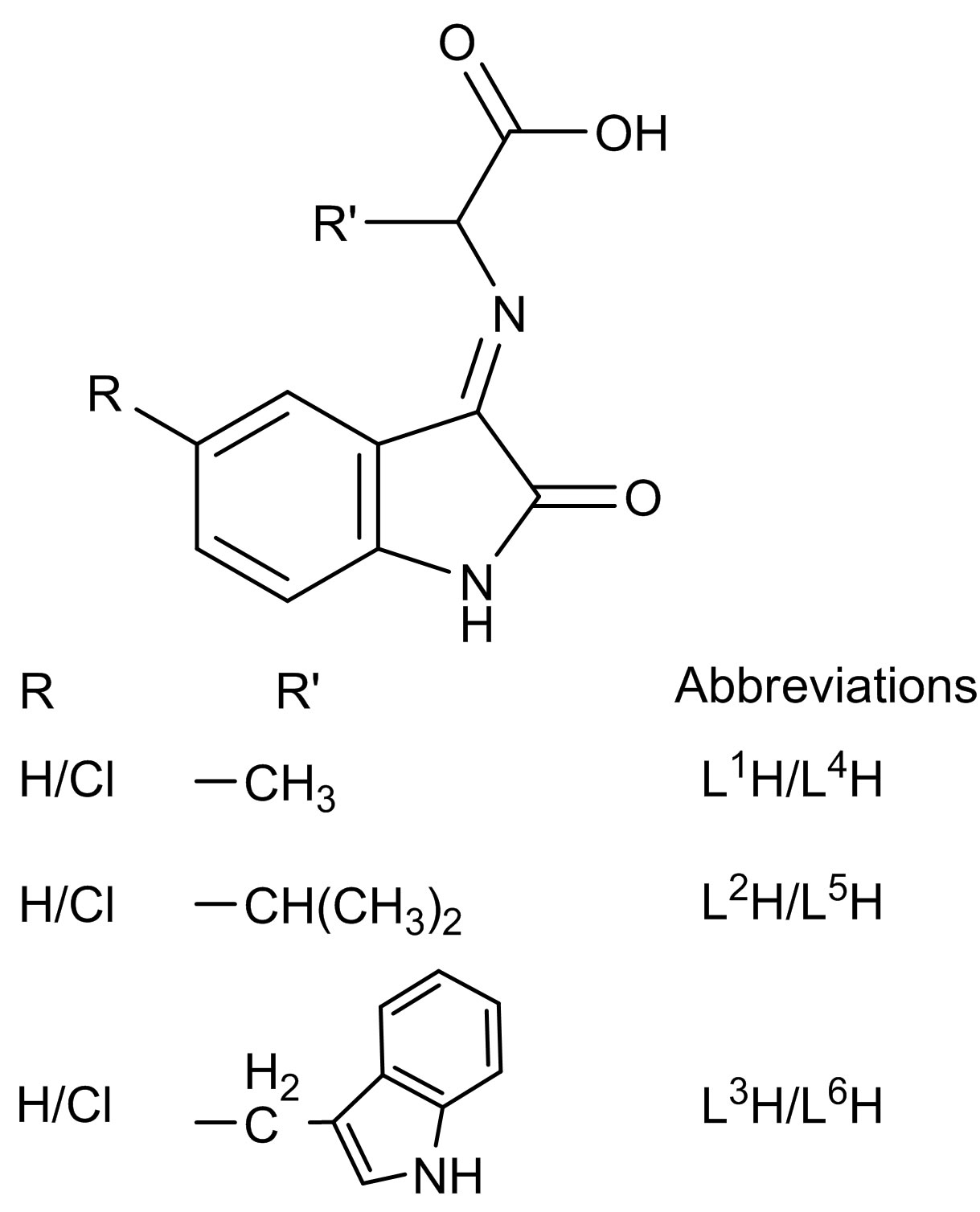
Figure 1. Proposed structure of the ligands.
standard. The 3D molecular modeling of a representative compound was carried out on a CS Chem. 3D Ultra Molecular Modeling and analysis program.
2.3. Syntheses of Schiff Base Ligands
The ligands were synthesized by the condensation of indoline-2,3-dione (0.231 g; 1.57 mmole), 5-chloroindoline-2,3-dione (0.285 g; 1.57 mmole) with amino acids (0.140 - 0.321 g; 1.57 mmole) (tryptophan, alanine and valine) in 1:1 molar ratio using methanol (100 mL) as the reaction medium and were then, it was refluxed for 6 - 8 hours. After this it was put on cooling at room temperature and the solid products were obtained. The excess solvent was removed on a rotary evaporator. It was dried further and then purified by recrystallization from same solvent (Table 1).
2.4. Syntheses of Organotin (IV) Complexes
Dibutyltin (IV) oxide (0.280 g; 1.125 mmole) was added to the calculated amount of the ligands (0.491 - 0.829 g; 2.250 mmole) in 1:2 molar ratio in dry benzene (80 mL), methanol (25 mL) mixture as reaction medium. The contents were refluxed on a fractionating column for about 6 - 8 hours. The water librated in the reaction was removed azeotropically with benzene. On completion of the reaction, the resulting products were rendered free from solvent and then washed repeatedly with dry cyclohexane. The crystalline solids were separated out and purified by recrystallization from the same solvent. The products so formed were finally dried in vacuum at 40˚C ± 5˚C for 2 - 3 hours. The purity of the complexes was checked by TLC using silica gel-G as adsorbent. Their physical properties and analytical data were recorded in table 2.
2.5. Antibacterial Assay
Synthesized compounds were screened for their antibacterial activity against Bacillus cereus (MTCC 0430) and Enterobacter aerogenes (MTCC 2824) at various concentrations 25, 50 and 100 μg by the agar Well Diffusion method [26]. 5 ml aliquot of nutrient broth was inoculated with the test organisms and incubated at 37˚C for 24 hours. Sterile nutrient agar plates were also prepared and holes of 5 mm diameter were cut using a sterile cork borer ensuring proper distribution. The test organisms after 24 hours of incubation were spread onto separate agar plates. The chemical compounds were dissolved in DMSO were poured into appropriately labeled holes using a pipette in aseptic conditions. A hole containing DMSO served as a control. Triplicate plate of each bacterial strain was prepared. The plates were incubated aerobically at 37˚C for 24 h. The antimicrobial

Table 1. Analytical and physical data of the ligands.
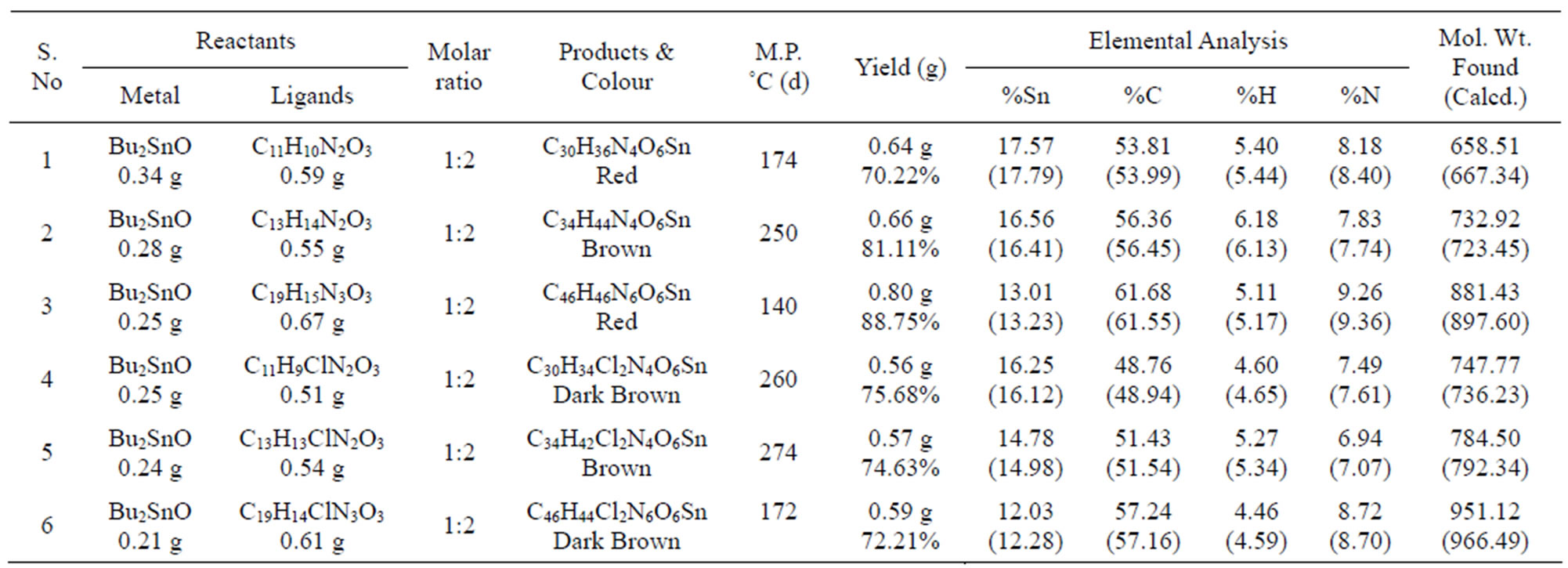
Table 2. Analytical and physical data of the organotin (IV) complexes.
activity was determined by measuring the diameter of the zone (mm) showing complete inhibition with respect to control (DMSO).
3. RESULTS AND DISCUSSION
The Schiff base (HL) and metal complexes are subjected to elemental analysis. The results of elemental analysis (C, H and N) with molecular formula and the melting points are presented in experimental part. The results obtained are in good agreement with those calculated for suggested formula. New organotin (IV) complexes were synthesized by the reaction of dibutyltin (IV) oxide with Schiff bases have been carried out in 1:2 molar ratios using anhydrous benzene and absolute methanol in 3:1 ratio as solvent. These reactions proceed with the liberation of water, which were azeotropically removed. The scheme of the Organotin (IV) complexes preparation is given by Scheme 1.
The above reactions were found to be quite facile and could be completed in 3 - 4 h of stirring. All these com-

Scheme 1. The scheme of the Organotin (IV) complexes preparation.
plexes are intensively coloured and solids. They are soluble in common organic solvents, DMF and DMSO. The compounds were dissolved in DMF and molar conductance 10−3 M of solution at 25˚C was measured. The molar conductance valves of the complexes fall in the range 14.85 to 26.14 W−1·cm2·mol−1 indicating that these compounds are non-electrolytes. The elemental analyses data (Table 1) agree with the proposed formulae for the ligands and also confirmed the Bu2SnL2 (Figure 2) composition of the diorganotin (IV) complexes.
3.1. IR Spectra
The IR spectra of the complexes were compared with those of the free ligands (Table 3) in order to determine
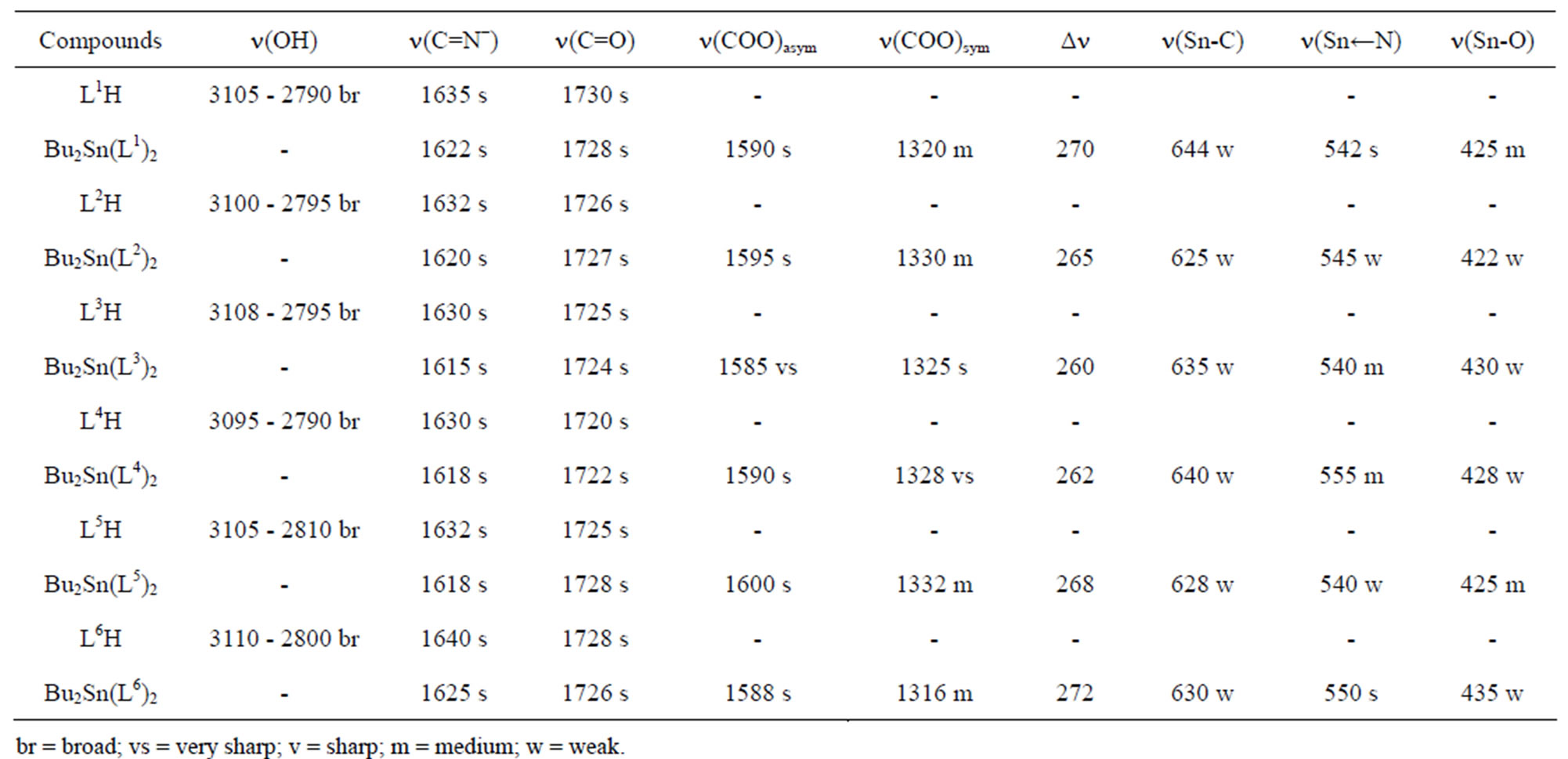
Table 3. Important IR spectral data (cm−1) of Schiff bases and their corresponding organotin (IV) complexes.

Figure 2. Structure of organotin (IV) complexes.
the coordination sites that may be involved in chelation. The position and the intensities of these peaks are expected to be changed on chelation. New peaks and quasipeaks are also a guide to chelation. The IR spectra of all the ligands [27] show the absence of band at 3450 and 1750 cm−1 due to ν(NH2) group of amino acids and ν (C=O) of isatin. Instead, a new prominent band at 1635 ± 5 cm−1 due to azomethine ν(C=N) linkage appeared in all the ligands [28,29] indicating that condensation between ketone moiety of isatin and that of amino group of amino acid has take place resulting into the formation of the desired ligands (L1H - L6H). Moreover, on comparison of the IR spectra of the ligands with their organotin (IV) complexes showed a major shift to lower wave numbers by 12 - 20 cm−1 in azomethine ν(C=N) at 1620 ± 5 cm−1 suggesting the involvement of the azomethine nitrogen with the organotin (IV) ion [30,31]. The new bands appeared in the region of 545 ± 10 cm−1 in the spectra of the complexes, are assigned to stretching frequencies of ν(Sn¬N) [31] bond formations.
The spectra of the ligands contain a broad absorption band appeared in the region 3110 - 2790 cm−1 which is assigned to hydrogen bonded ν(OH). This band disappears on complexation, suggesting chelation of the oxygen to the tin atom [32]. The infrared spectra of complexes revealed that the νasym(COO−) was shifted to a lower wave number compared to the parent ligands which signify that the coordination took place via the oxygen atom of the carboxylate anion. Complexes showed the νasym(COO−) and νsym(COO−) are in the range of 1600 - 1585 and 1330 - 1316 cm−1, respectively [33,34].
Upon complexation, the structures of the ligands are altered, all alterations can be observed through the shift of the characteristic bands. The remarkable change is the disappearance of ν(OH) (3110 - 2790 cm−1). This is attributable to νasym(COO−) and νsym(COO−) existing in the spectra of all the complexes, thus supporting the deportonation of carboxylic group and coordination of its carboxylic oxygen to the tin(IV) ion. The magnitude of Δν = [νasym(COO−) – νsym(COO−)] for the complexes falls in the range of 272 - 260 cm−1, indicating the carboxyl group in all the complexes is bound in monodentate manner [35]. Moreover, for complexes Δν below 200 cm−1 would be expected for bridging or chelating carboxylate, but greater than 200 cm−1 for the monodentate bonding carboxylate anions. Further evidence for the coordination to tin via oxygen atom was revealed by the presence of the ν(Sn-O) [36] stretching bands in the spectra of complexes (1 - 6) in the region of 422 - 435 cm−1. New band appear in the complexes at 630 ± 5 cm−1 is probably due to ν(Sn-C) [37] stretching.
3.2. Electronic Spectra
The spectra of the ligands and their complexes were recorded in dry DMSO. The various bands observed were assigned to interligand and charge transfer of n-π* transition according to their energies and intensities. Electronic spectra of the complexes exhibit three bands in the region 200 - 235, 250 - 345 and 365 - 430 nm, which may be due to the π-π* transition of benzenoid, π-π* transition of COO and π-π* transition of the >C=N− chromophore, respectively. Further, there was a sharp band observed in the 250 ± 5 nm regions in the spectra of the complexes, which could be assigned as a charge transfer band. It has been reported that a metal is capable of forming dπ-pπ* bonds with ligands containing nitrogen or oxygen as the donor atoms. Since tin atom has its 5d orbitals completely vacant, L-M bonding can take place by the acceptance of a pair of electrons from nitrogen or oxygen atoms of the ligands.
3.3. 1H NMR Spectra
All the protons were found as to be in their expected regions (table 4). The conclusions drawn from these studies lend further support to the mode of bonding discussed in their IR spectra. In the spectra of organotin (IV) complexes, coordination of the ligands via azomethine nitrogen and carboxylate oxygen was established by the downfield shifting of these signals in the organotin (IV) complexes, because of the increased conjugation and coordination [38]. The number of protons calculated from the integration curves and those obtained from the values of the expected CHN analyses agree with each other. It was observed that DMSO had no coordinating effect either on the spectra of the ligands or on its metal complexes. In the proton magnetic resonance spectra of the ligands, give an OH proton signals at δ 11.25 - 11.50 ppm (s) which is absent from the spectra of the corresponding lead complexes, showing thereby chelation of the ligand moiety through the deprotonated carboxylate oxygen. The ligands give a complex multiplet signal in the region δ 6.95 - 7.89 ppm (m) for the aromatic protons and these remain almost at the same position in the spectra of the metal complexes. The appearance of signals due to NH protons at the same positions in the ligand and its complexes show the non-involvement of this group in coordination. The complexes, however, show additional signals at δ 0.72 - 1.90 ppm owing to the protons of the

Table 4. 1H NMR spectral dataa of the ligands and their corresponding organotin (IV) complexes.
butyl group. The CH3 protons of dibutyltin compounds are significant as a triplet at 0.78 - 82 ppm with 3JHH = 7.4 Hz, while –CH2-protons appear as a multiplet. The most important information obtained from 1H NMR values in these compounds, demonstrates that diorganotion complexes show the coordination number greater than four, probably six, in non coordinating solvent.
3.4. 13C NMR Spectra
The 13C NMR spectral data for L1H, L2H, L4H and its corresponding tin complexes have been recorded in dry DMSO (Table 5). The formations of the complexes were evident from the δ(COO) value in the 13C NMR spectra. All the complexes exhibited a δ(COO) signal in the range of 172 - 178 ppm. The 13C NMR spectra of complexes showed that the chemical shift of the δ(COO) signal in each complexes was shifted downfield compared to that of their parent ligands (~δ 175 ppm), indicating the participation of the carboxylate anion in the coordination to the tin atom. The occurrence of resonances in the range of 110 - 150 ppm in the 13C NMR spectra of the complexes and ligands defined as benzene signals. The carbon of the butyl group is observed at (δ ~ 26.6, 27.8, 26.0, 14.3 ppm) position comparable to other similar compounds. The R group attached to tin displays resonance for chemically equivalent carbon; however, the butyl compounds display three resonances. Coordination of the tin atom has been related to 1J(119Sn-13C) coupling constants. The nJ(119Sn-13C) coupling constant values (n = l, 925 Hz; n = 2, 40.6 Hz; and n = 3, 126.1 Hz) obtained for the synthesized complexes are indicative of hexa coordination of dibutyltin complexes. The carbons of alkyl groups attached to tin are observed at position comparable with other, similar compounds [39, 40].
3.5. 119Sn NMR Spectra
The value of δ(119Sn) define the coordination number of the central tin atom. The results are listed in table 5. All the complexes, 119Sn NMR spectra show only a sharp singlet indicating the formation of a single species. For diorganotin(IV) complexes, the δ(119Sn) value for fourcoordinated complexes fall in the range between δ + 200 to δ − 60 ppm; for five-coordinated complexes fall in the range between δ − 90 to δ − 190 ppm and for six-coordinated complexes fall in the range between δ − 210 to δ − 400 ppm. Complexes 1 - 6 derivatives of dibutyltin(IV) exhibited δ(119Sn) values at ~δ − 360 ppm which lie in the range of δ − 210 to δ − 400 ppm, hence, indicating that the tin atom in all the complexes have six-coordinated and have a distorted octahedral geometry [41-43].
On the basis of the above mentioned different spectral studies, it is suggested that the bonding through the azomethine nitrogen and carboxylate oxygen atoms to the tin atom. Finally, distorted octahedral geometries around the tin atom have been proposed as shown in Figure 2.
3.6. Molecular Modeling and Analysis
In view of the hexa-coordination of the present tin complexes, [Bu2Sn(L1)2], the molecular modeling of the compound as a representation, is based on its octahedral structure and all the 237 measurements are obtained (bond angles, 155 in numbers and the bond lengths, 82 in numbers). In most of the cases, the actual bond angles and lengths are close to the optimal values, and thus the proposed structure of the compound is acceptable (Figure 3). In compound [Bu2Sn(L1)2], the Sn atom is 2.01 and 3.9 Å away from the oxygen’s of the carboxylic group. The two long Sn-O bond being Trans to each other. The C-O bonds are nearly (1.39 and 1.21 Å). The two butyl groups are equidistant from Sn (2.10 Å) and complete the
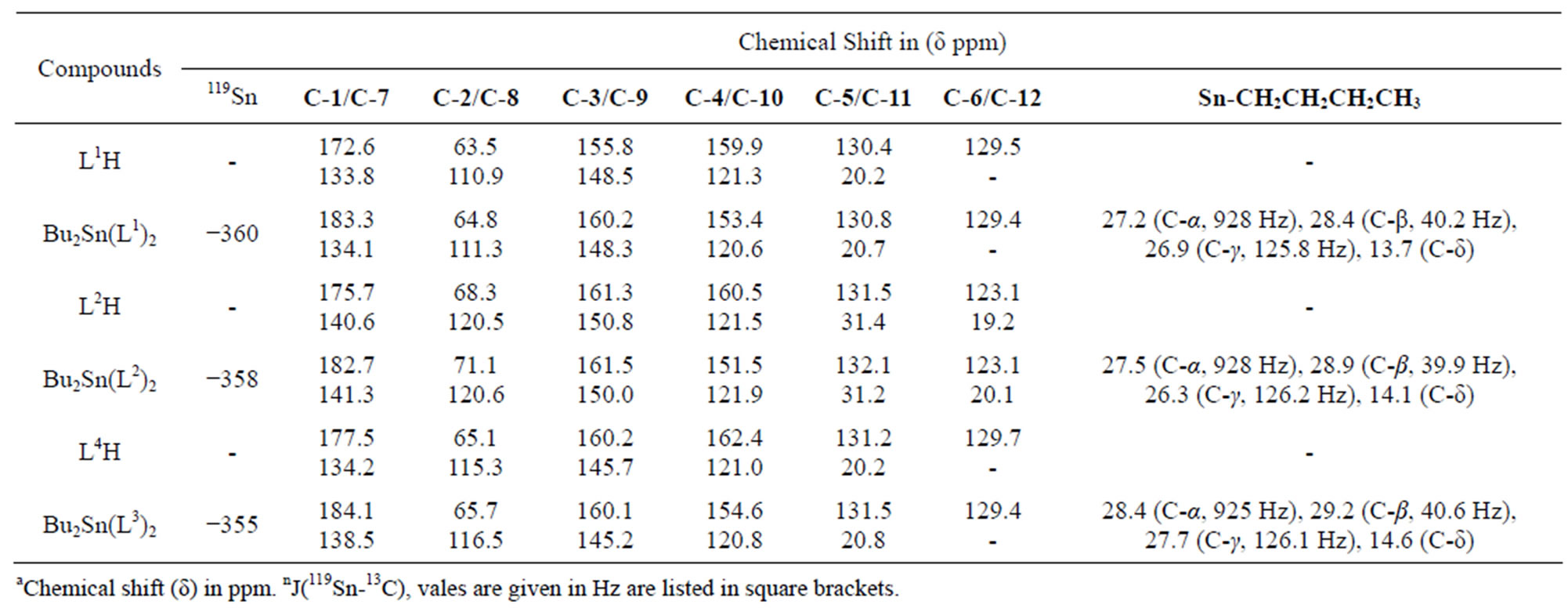
Table 5. 13C and 119Sn NMR spectral dataa of the ligands and their corresponding organotin (IV) complexes.
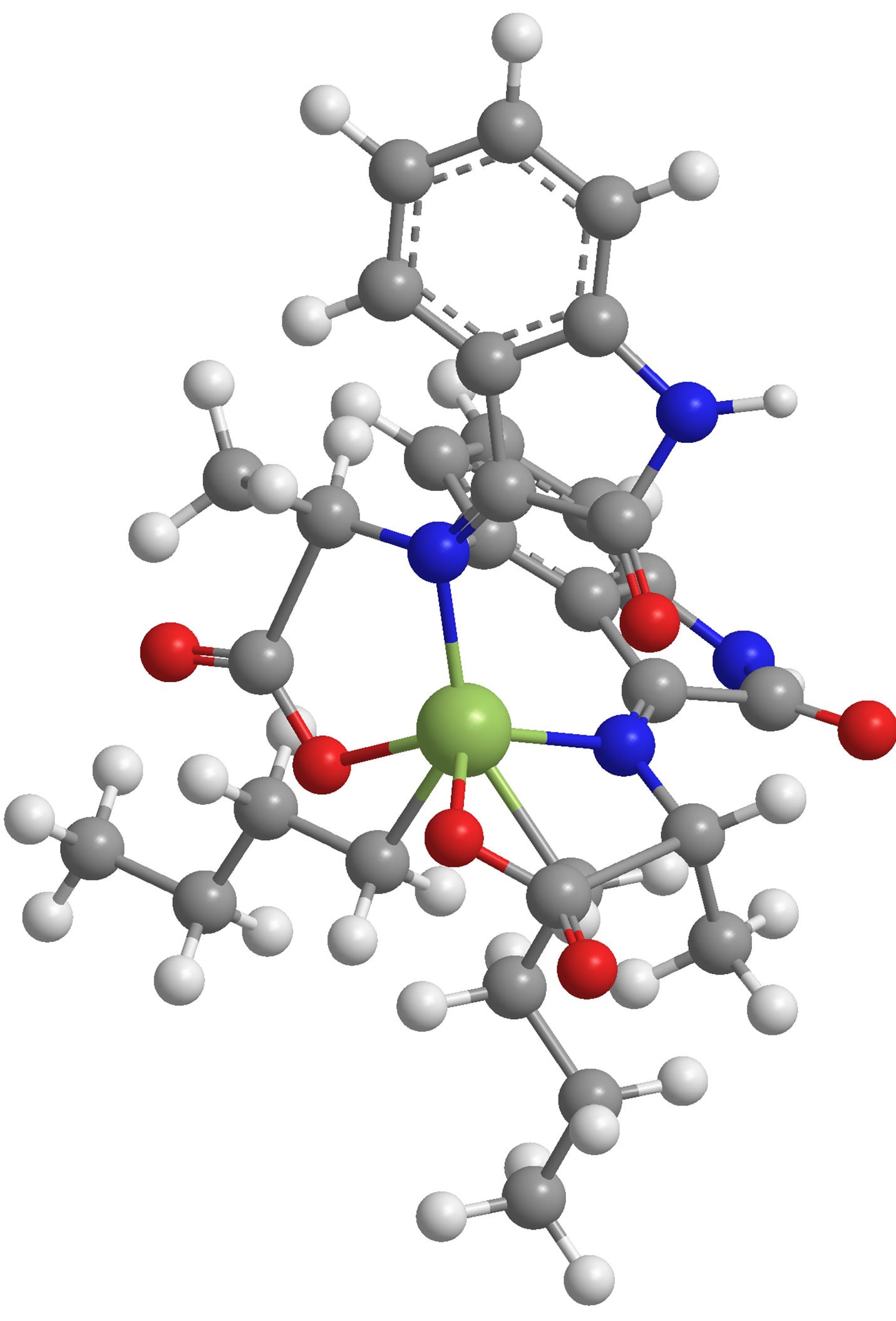
Figure 3. 3D structure of the [Bu2Sn(L1)2] complexes.
coordination sphere of Sn. The Bu(C)-Sn-(C)Bu angles are 162.1˚. The O-Sn-O and N-Sn-N angle are 109.5 and is 110.5˚, respectively for both the carboxylic ligands.
3.7. Antimicrobial Results
In vitro antibacterial activity of the ligands and their corresponding organotin complexes was tested against Gram-positive and Gram-negative (Enterobacter aerogenes and Bacillus cereus) bacteria. The agar well-diffusion method was used in these assays and each experimental was performed in triplicate. The zone of inhibittion value represents the mean value of three readings, which are shown in Table 6. The results show that all compounds exhibit antibacterial activity and in many case, the organotin complexes are more potent in their inhibition properties than the free ligands. This can be explained in terms of the greater lipid solubility and cellular penetration of the complexes [44]. It is clear that the coordination enhances the antibacterial activity and clearly indicates that the newly synthesized complexes in the present studies are more active against Gram-positive than Gram-negative bacteria. The preliminary results achieved have led us to conclude that these types of complexes should be studied in detail for their applications in diverse areas.
The screening data of a particular ligand and its metal complexes show that the former has greater activity than the latter from the biochemical point of view. On comparing the results in general, it may be concluded that the
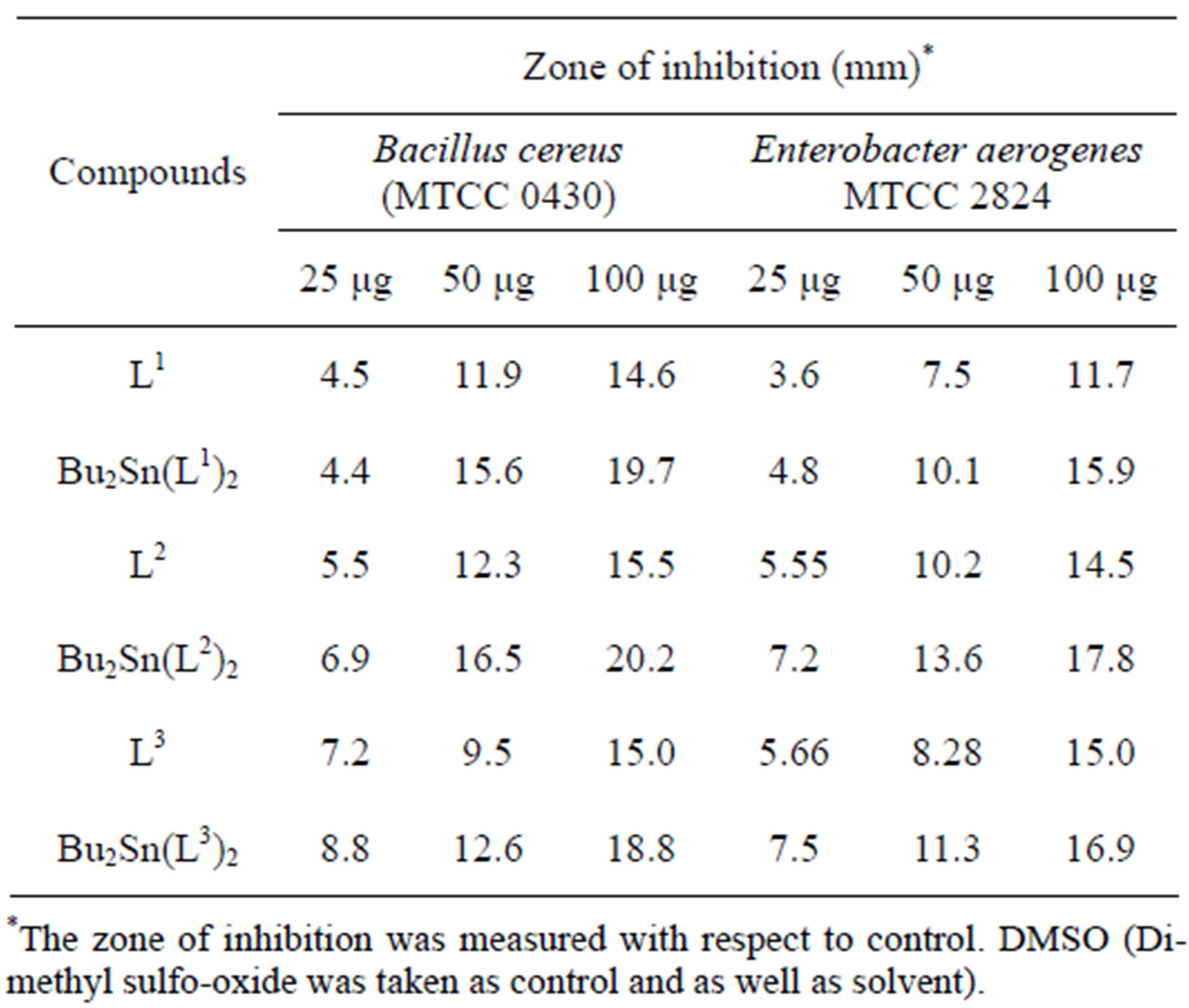
Table 6. Antibacterial and antifungal activity of ligands and their organotin (IV) complexes.
organotin (IV) complexes have greater inhibiting power than the free ligands against all the microbes. Although it is difficult to make out an exact structure-activity relationship between the antimicrobial activity and the structure of these complexes, it can possibly be concluded that the chelation as well as the addition of a substrate enhance the activity of the complexes. The variation in the toxicity of different antibacterial agents against vari- ous organisms depends on either the impermeability of the cell or differences in site of action or ability to cause mutations in the microorganism. Though the results suggest that the ligands have a remarkable toxic property, their complexes of tin inhibit the growth of microorganisms to a greater extent. This is in accordance with earlier reports [45]. Further, the greater activity of the complexes can also be explained on the basis of their higher solubility of the particles.
4. CONCLUSION
The newly synthesized Schiff bases act as bidntate ligands coordinating to metal ion through azomethine nitrogen, and carboxylate oxygen atom. Distorted octahedral geometries have been proposed for diorganotin (IV) complexes with the help of different spectral studies like IR, UV, 1H, 13C and 119Sn NMR. The Schiff bases and their metal complexes were found to be active against some of the antibacterial and antifungal species. The activity is significantly increased on coordination.
5. ACKNOWLEDGEMENTS
The authors are thankful to the Dean, FET and Prof. K Singh, Head, department of science and humanities, FET, Mody Institute of Technology and Science, Deemed University, Lakshmangarh, for providing necessary research facilities in the department.
REFERENCES
- Li, C., Kanehisa, N., Miyagi, Y., Nakao, Y., Takamizawa, S., Mori, W. and Kai, Y. (1997) Syntheses, structures, and properties of the dinuclear copper(II) and nickel(II) complexes bridged by an alkoxide and a pyridazine or a phthalazine. Bulletin of the Chemical Society of Japan, 70, 2429-2436. doi:10.1246/bcsj.70.2429
- Ibrahim, E.S., Sallam, S.A., Orabi, A.S., El-Shetary, B.A. and Lentz, A. (1998) Schiff bases of acetone derivatives: Spectroscopic properties and physical constants. Monatshefte fur Chemie, 129, 159-171. doi:10.1007/PL00010152
- Campos, A., Anacona, J.R. and Campos, M.M. (1999) Synthesis and IR study of a Zn(II) complex containing a tetradentate macrocyclic Schiff base Ligand antifungal properties. Main Group Metal Chemistry, 22, 283-288. doi:10.1515/MGMC.1999.22.5.283
- Sengupta, S.K., Pandey, O.P., Rai, A. and Sinha, A. (2006) Synthesis, spectroscopic, thermal and antifungal studies on lanthanum(III) and praseodymium(III) derivatives of 1,1-diacetylferrocenyl hydrazones. Spectrochimica Acta A, 65, 139-142. doi:10.1016/j.saa.2005.09.037
- Qi, G.-F., Yang, Z.-Y and Wang, B.-D. (2007) Synthesis, characterization and DNA-binding properties of zinc(II) and nickel(II) Schiff base complexes. Transition Metal Chemistry, 32, 233-239. doi:10.1007/s11243-006-0160-8
- Singh, V. P. and Katiyar, A. (2008) Synthesis, spectral characterization and antimicrobial activity of some transition metal(II) complexes with acetone p-amino acetophenone benzoylhydrazone. Pesticide Biochemistry and Physiology, 92, 8-14. doi:10.1016/j.pestbp.2008.04.003
- Cozzi, P. G. (2004) Metal-Salen Schiff base complexes in catalysis: Practical aspects. Chemical Society Reviews, 33, 410-421. doi:10.1039/b307853c
- Iqbal, A., Siddiqui, H.L., Ashraf, C.M., Bukhar, M.H. and Akram, C.M. (2007) Synthesis, spectroscopic and cytotoxic studies of biologically active new Schiff Bases derived from p-nitrobenzaldehyde. Chemical and Pharmaceutical Bulletin, 55, 1070-1072. doi:10.1248/cpb.55.1070
- Offiong, O.E. and Martelli, S. (1997) Stereochemistry and antitumour activity of platinum metal complexes of 2-acetylpyridine thiosemicarbazones. Transition Metal Chemistry, 22, 263-269. doi:10.1023/A:1018416624951
- Maurya, R.C., Rajput, S. and Martin, H. (2006) Metal chelates as oral potential insulin adjuvants: Studies on some oxovanadium(IV) chelates involving biomimetic ono-donor sugars. Medicinal Chemistry Research, 15, 82- 83.
- Singh, H.L. and Varshney, A.K. (2006) Synthetic, structural, and biochemical studies of organotin (IV) with schiff bases having nitrogen and sulphur donor ligands. Bioinorganic Chemistry and Applications, 2006, 1-7. doi:10.1155/BCA/2006/23245
- Singh, H.L., Sharma, M. and Varshney, A.K. (2000) Studies on coordination compounds of organotin (IV) with Schiff bases of amino acids. Synthesis and Reactivity in Inorganic and Metal-Organic Chemistry, 30, 445-456.
- Siddiqi, H.L., Iqbal, A., Ahmad, S. and Weaver, W. (2006) Synthesis and spectroscopic studies of New Schiff bases. Molecules, 11, 206-211. doi:10.3390/11020206
- Kim, S.-H., Gwon, S.-Y., Burkinshaw, S. M. and Son, Y.-A. (2010) The synthesis and proton-induced spectral switching of a novel azine dye and its boron complex. Dyes and Pigments, 87, 268-271. doi:10.1016/j.dyepig.2010.04.006
- Kumbhar, A.S., Padhye, S.B., West, D.X. and Liberta, A.E. (1991) Electrochemical studies of copper(II) 2-acetylpyridine4N-dialkylthiosemicarbazones.Relation to their spectral, magnetic, and biological properties. Transition Metal Chemistry, 16, 276-279. doi:10.1007/BF01032852
- Gielen, M. (2002) Review: Organotin compounds and their therapeutic potential. Applied Organometallic Chemistry, 16, 481-494. doi:10.1002/aoc.331
- Gielen, M., Biesemans, M. and Willem, R. (2005) Organotin compounds: From kinetics to stereochemistry and antitumour activities Applied Organometallic Chemistry, 19, 440-450. doi:10.1002/aoc.771
- Valent, A., Melník, M., Hudecová, D., Dudová, B., Kivekäs, R. and Sundberg, M.R. (2002) Copper(II) salicylideneglycinate complexes as potential antimicrobial agents. Inorganica Chimica Acta, 340, 15-20. doi:10.1016/S0020-1693(02)01062-9
- Nath, M., Singh, H., Eng, G. and Song, X. (2011) Interaction of organotin(IV) moieties with nucleic acid constituent: Synthesis, structural characterization and antiinflammatory activity of tri-i-propyltin(IV) and diorganotin(IV) derivatives of guanosine. Inorganic Chemistry Communications, 14, 1381-1385. doi:10.1016/j.inoche.2011.05.027
- Pellerito, C., Nagy, L., Pellerito, L. and Szorcsik, A.C. (2006) Biological activity studies on organotin(IV)n+ complexes and parent compounds. Journal of Organometallic Chemistry, 691, 1733-1747. doi:10.1016/j.jorganchem.2005.12.025
- Ahmad, M. S., Hussain, M., Hanif, M., Ali, S. and Mirza, B. (2007) Synthesis, chemical characterization and biological screening for cytotoxicity and antitumor activity of organotin (IV) derivatives of 3,4-methylenedioxy 6- nitrophenylpropenoic acid. Molecules, 12, 2348-2363. doi:10.3390/12102348
- Saxena, A. and Tandon, J. P. (1983) Antitumor activity of some diorganotin and tin(IV) complexes of Schiff bases. Cancer Letters, 19, 73-76. doi:10.1016/0304-3835(83)90138-6
- Baul, T.S.B., Paul, A., Pellerito, L., Scopelliti, M., Singh, P., Verma, P., Duthie, A., De Vos, D. and Tiekink, E.R.T. (2011) Dibutyltin(IV) complexes containing arylazobenzoate ligands: Chemistry, in vitro cytotoxic effects on human tumor cell lines and mode of interaction with some enzymes. Investigational New Drugs, 29, 285-299. doi:10.1007/s10637-009-9360-3
- Sadiq-ur-Rehman, Shahid, K., Ali, S., Bhatti, M. H. and Parvez, M. (2005) Organotin esterification of (E)-3-(3- fluoro-phenyl)-2-(4-chlorophenyl)-2-propenoic acid: Synthesis, spectroscopic characterization and in vitro biological activities. Crystal structure of [Ph3Sn(OC(O)C (4-ClC6H4) = CH(3-FC6H4))]. Journal of Organometallic Chemistry, 690, 1396-1408. doi:10.1016/j.jorganchem.2004.12.004
- Perrin, D.D., Armarego, W.L.F. and Perrin, D.L. (1998) Purification of laborartory chemicals. 3rd Edition, Pergamon, London.
- Singh, H.L., Singh, J.B. and Sharma, K.P. (2012) Synthetic, structural, and antimicrobial studies of organotin (IV) complexes of semicarbazone, thiosemicarbazone derived from 4-hydroxy-3-methoxybenzaldehyde. Research on Chemical Intermediates, 38, 53-65. doi:10.1007/s11164-011-0325-8
- Ran, X., Wang, L., Cao, D., Lin, Y. and Hao, J. (2010) Synthesis, characterization and in vitro biological activity of cobalt(II), copper(II) and zinc(II) Schiff base complexes derived from salicylaldehyde and D,L-selenomethionine. Applied Organometallic Chemistry, 25, 9-15. doi:10.1002/aoc.1680
- Singh, K., Kumar, Y. and Pundir, R.K. (2010) Synthesis and Characterization of biologically active organosilicon (IV) complexes with schiff bases derived from o-aminothiophenol. Synthesis and Reactivity in Inorganic and Metal-Organic Chemistry, 40, 836-842.
- Nath, M., Saini, P.K. and Kumar, A. (2010) New diand triorganotin(IV) complexes of tripodal Schiff base ligand containing three imidazole arms: Synthesis, structural characterization, anti-inflammatory activity and thermal studies. Journal of Organometallic Chemistry, 695, 1353- 1362. doi:10.1016/j.jorganchem.2010.02.009
- Ferrero, J.R. (1971) Low-frequency vibrations of inorganic and coordination compounds, John Wiley & Sons, New York.
- Singh, H.L. and Varshney, A.K. (2001) Synthesis and characterization of coordination compounds of organotin (IV) with nitrogen and sulphur donor ligands. Applied Organometallic Chemistry, 15, 762-768. doi:10.1002/aoc.234
- Singh, H.L. (2010) Synthesis and characterization of tin (II) complexes of fluorinated Schiff bases derived from amino acids. Spectrochimica Acta Part A, 76, 253-258. doi:10.1016/j.saa.2010.03.029
- Sandhu, G.K. and Verma, S.P. (1987) Triorganotin(IV) derivatives of five membered heterocyclic 2-carboxylic acids. Polyhedron, 6, 587-591. doi:10.1016/S0277-5387(00)81029-3
- Szorcsik, A., Nagy, L., Sletten, J., Szalontai, G., Kamu, E., Fiore, T., Pellerito, L. and Kálmán, E. (2004) Preparation and structural studies on dibutyltin(IV) complexes with pyridine monoand dicarboxylic acids. Journal of Organometallic Chemistry, 689, 1145-1154. doi:10.1016/j.jorganchem.2003.11.040
- Ho, B.Y.K. and Zuckerman, J.J. (1973) Trialkyltin derivatives of amino acids and dipeptides. Inorganic Chemistry, 12, 1552-1561. doi:10.1021/ic50125a016
- Sedaghat, T. and Jalilian, F. (2009) New adducts of diorganotin(IV) Chlorides with a new multifunctional Schiff base ligand: Synthesis and spectral properties. Journal of Iranian Chemical Society Synthesis, 6, 271-276.
- Singh, H.L. and Varshney, A.K. (1999) Synthesis and spectral studies of organotin(IV) complexes with bifunctional tetradentate Schiff bases. Main Group Metal Chemistry, 22, 529-532. doi:10.1515/MGMC.1999.22.9.529
- Pasto, D.J. (1969) Organic structure determination, Prentice Hall, London.
- Nath, M. and Yadav, R. (1998) Studies of organotin(IV) derivatives of DL-methionine and L-asparagine. Bulletin of the Chemical Society of Japan, 71, 1355-1362. doi:10.1246/bcsj.71.1355
- Joshi, A., Verma, S., Gaur, R. B. and Sharma, R. R. (2005) Di-n-butyltin(IV) Complexes Derived from Heterocyclic β-diketones and N-phthaloyl amino acids: Preparation, biological evaluation, structural elucidation based upon spectral [IR, NMR (1H, 13C, 19F and 119Sn)] studies. Bioinorganic Chemistry and Applications, 3, 201-215. doi:10.1155/BCA.2005.201
- Holeček, J., Nádvorník, M., Handlíř, K. and Lyčka, A. (1986) 13C and 119Sn NMR spectra of Di-n-butyltin(IV) compounds. Journal of Organometallic Chemistry, 315, 299-308. doi:10.1016/0022-328X(86)80450-8
- Jain, V. K., Mason, J., Saraswat, B.S. and Mehrotra, R.C. (1985) 15N, 13C and 119Sn NMR and other spectroscopic studies of 8-quinolinol, its Oand N-methyl derivatives, and chelate diand tri-organotin(IV) complexes. Polyhedron, 4, 2089-2096. doi:10.1016/S0277-5387(00)86741-8
- Pettinari, C., Pellei, M., Miliani, M., Cingolani, A., Cassetta, A., Barba, L., Pifferi, A. and Rivarola, E. (1998) Tin(IV) and organotin(IV) complexes containing mono or bidentate N-donor ligands: III.1 1-methylimidazole derivatives: synthesis, spectroscopic and structural characterization. Journal of Organometallic Chemistry, 553, 345-369. doi:10.1016/S0022-328X(97)00606-2
- Chaturvedi, K.K. and Goyal, M. (1984) Antibacterial studies of 7-(α-substituted sulphonamido)methyland 7-(α-substituted sulphonamido)phenyl-8-hydroxyquinolines. Journal of the Indian Chemical Society, 61, 175- 176.
- Singh, H.L., Khungar, B., Tripaati, U.D. and Varshney, A.K. (2001) Spectral and antimicrobial studies of organotin(IV) complexes of bidentate schiff bases having nitrogen and sulphur donor systems. Main Group Metal Chemistry, 24, 5-12. doi:10.1515/MGMC.2001.24.1.5

